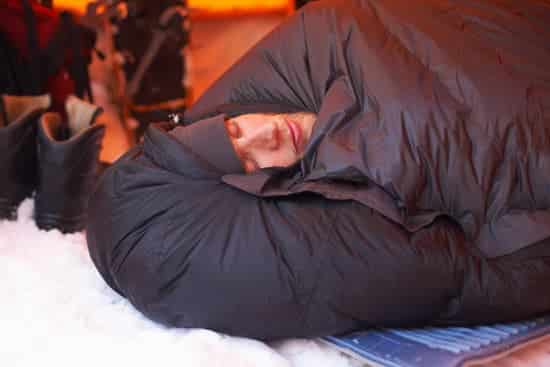Are you struggling to stay warm in your sleeping bag? After throwing down your hard-earned money on a new sleeping, the last thing that you want is to be up all night tossing and turning desperately fighting to keep warm. Luckily, you can increase your sleeping bags warmth by following a few simple tips! How do you stay warm in a sleeping bag?
There are lots of methods to increase sleeping bag warmth, but here are a few simple tips to stay warm in a sleeping bag. Pick your sleeping bag based on the temperature rating, use a high R-Value sleeping pad, add in a sleeping bag liner, wear extra insulating layers, choose a cold weather tent, and find alternative heat sources.
There’s no reason to every be cold in your sleeping bag! With a little work, and basic planning you can stay warm regardless of the weather. Why should you be cold and miserable when all it takes is a few basic tips to get the most out of your sleeping bag.
You don’t even need to spend a lot of money. Why buy an expensive sleeping bag for no good reason? By making a few simple tweaks to your sleep system you can stay warm on even the coldest night. In the rest of this post I’ll explain how to stay warm at night and go into detail about choosing the right gear, layering clothes, and help you find the warmest sleeping bag possible.
Table Of Contents
How To Increase Sleeping Bag Warmth
Don’t worry if you’ve been tossing and turning in your sleeping bag struggling to stay warm. There’s still hope! You should easily be able to increase your sleeping bags warmth. You might have to spend a little bit of money to get the most out of your gear, but it’s easy to increase the warmth of your sleeping bag.
Choosing the right sleeping bag is the most important step, but there are ways to get around an inadequate sleeping bag. You shouldn’t have any trouble staying warm if you follow these simple steps!
- Sleeping Bags Temperature Rating: Look at your sleeping bags temperature rating to determine the minimum temperature you can handle. Understand that this is a minimum temperature for the average person so 50% of the population would feel cold at those temperatures. That’s why I recommend looking for a sleeping bag that’s rated 15°F lower than the expected night time temperature. Once you figure out your budget I recommend looking at 40° sleeping bags for 3-Season use. That will get you through spring, summer, and fall. You can further extend the functionality of your sleeping bag by layering clothes and using a sleeping bag liner.
- Use A Sleeping Bag Liner: You shouldn’t solely rely on your sleeping bag to keep you warm. A sleeping bag liner will pad your sleeping bags temperature rating making it usable in colder weather. A Sea To Summit Thermolite Liner adds 25°F and their Thermolite Fleece Liner Adds 32°F to your sleeping bags temperature rating. It’s crazy how much a high quality liner can increase your sleeping bags temperature rating. Even a cheap Coleman liner will add 12°F to your bag’s rating.
- Buy A High R-Value Sleeping Pad: A sleeping pad isn’t just about adding comfort! Sleeping pads insulate your body against the cold hard ground. There’s no chance of staying warm in cold weather without a high quality sleeping pad. I’ll go over sleeping pads in depth below, but I recommend a 3-4 R-Value sleeping pad for chilly spring/fall weather and 5 R-Value pad for the winter.
- Wear Layers: Wear multiple layers to conserve body heat on cold nights. Extra layers add insulation between your body and the cold outside air. I like to sleep in whatever base layer I plan on wearing the following day. Something like long johns, long sleeve shirt, light jacket, etc. You can add in a winter hat, sweatpants, snow pants, heavy jacket in freezing weather. Your clothing’s the last step to battle the cold so spend most of your time on buying the right sleeping bag, liner, and pad.
- Buy The Right Tent: A simple question always comes up, is it warmer inside a tent? The answer is an enthusiastic yes! The type of tent you choose will play a subtle yet important part of keeping you warm at night. A standard 3-Season tent won’t offer much warmth (5°F Max), but it will help block the wind. You’ll start noticing a major difference once you get into 4-Season winter tents (15°F) and mountaineering tents (25°F). Don’t just go out and buy a winter tent just because you want the added warmth! Using a winter tent in the summer will be unbearably hot and cause serious condensation issues.
- Prevent Moisture: Tent moisture comes from two primary sources. You have moisture that you brought in on wet gear and condensation from temperature imbalances. Removing wet gear solves 90% of the battle against condensation. Condensation can’t be completely eliminated, because of sweat and the moisture that comes out as you breathe, but eliminating outside sources will help keep your sleeping bag dry at night.
- Alternate Heat Sources: A well thought out sleep system is the best way to stay warm at night, but there are other tricks to heat up tents. Use portable propane heaters like Mr. Heater, share a tent, buy hand warmers and add hot water bottles to a sleeping bag. Every day, campers come up with ingenious ways to get extra warmth.
I’ll go over each of these steps below, but let’s start out by going over the basics. How do you pick out a sleeping bag and what do temperature ratings mean?
Do Sleeping Bags Keep You Warm? Sleeping Bag Temperature Ratings Explained
Do sleeping bags keep you warm? Yes a sleeping bag will keep you warm if you choose the right bag, but you need to figure out the rest of your sleep system as well. The sleeping bag protect the top of your body, but you need a high R-Value sleeping pad to protect the bottom. You’ll be cold and miserable if you don’t get every part of your sleep system down.
Let’s ignore packability and trail weight for a minute. Those factors are very important for backpackers, but it won’t affect warmth. You will have to spend a lot of money to buy a sleeping bag that’s both lightweight and extremely warm.
How do you pick a sleeping bag to keep you warm? You need to start off by looking at the sleeping bags temperature rating. The temperature rating is the lowest temperature the bag will keep the average sleeper warm. Are you a person that gets cold easily?
Most women, children, and people with certain medical disabilities that affect circulation will need a warmer sleeping bag than the stated temperature rating. Using a sleeping bag liner and layering clothing will help, but I recommend purchasing a sleeping bag that’s 15°F warmer than expected night time temps.
That will also help avoid being cold with unexpected temperature swings. It can be almost impossible to predict the weather on fall/spring nights. Temperatures can fluctuate from warm and sunny at 60°F on the first day and dip into the 30s by day 2. You need to find a sleeping bag that can accomodate the lowest possible temperature. From there you can use sleeping bag liners, and layer insulated clothing to further pad your bags rating.
1) How Does A Sleeping Bag Keep You Warm?
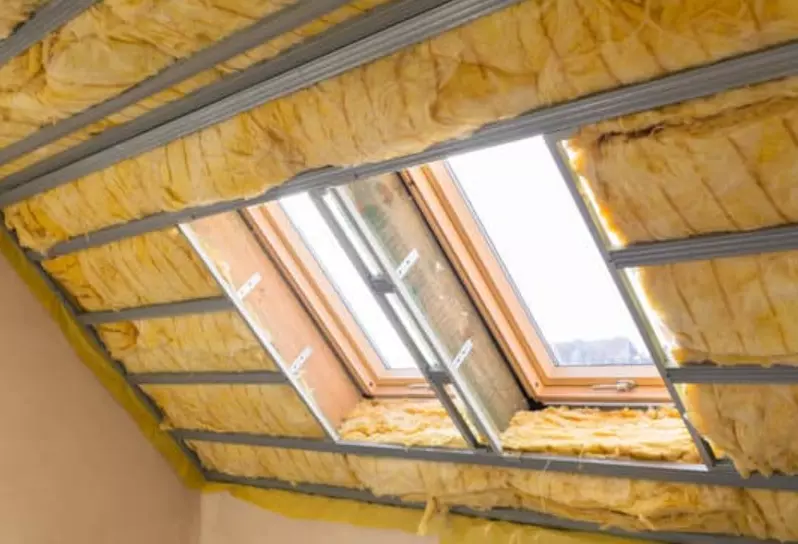
The sleeping bag is by far the most important piece of your sleep system. Let’s briefly go over how sleeping bags work by painting a simple picture. Think of your sleeping bag as if it were a house. As you add insulation to the outside walls it will increase the efficiency of your furnace. The furnace won’t have to work as hard to maintain consistent temperatures.
Your sleeping bag works in the exact same way, by trapping your body heat in the air surrounding your body. Your body works releases 8 watts of heat per hour and that would be lost to the surrounding air without adequate insulation. Bags with higher temperature ratings have more insulation allowing them to trap that heat longer. If your sleeping bag doesn’t have a high enough temperature rating you will lose heat faster than your body can generate it making you cold.
Every additional layer of insulation between your body and the surrounding cold air will slow down the transfer of heat. Heat always travels from hot surfaces into cooler areas nearby. So it will slowly works its way through your sleeping bags insulation layer trying to heat up the surrounding air.
Down vs Synthetic Insulation

Here’s one of those questions that gets asked all the time: are down sleeping bags warmer than synthetic? That’s a question with a not so simple answer. If you’re comparing down and synthetic sleeping bags side by side, a similar weight down bag will almost always be warmer than synthetic.
With that being said, you still need to look at the bags temperature rating and fill power to get a clearer picture. A sleeping bags temperature rating will tell you almost everything you need to know. Two sleeping bags, one down and the other synthetic, with the same temperature rating will offer a similar amount of warmth.
The magic of down insulation is that it can provide that warmth at a lower trail weight, but not all down bags are the same. You have to compare the down insulations fill power with how much fill is in the bag. High fill power down will offer more warmth for less weight, but you can still get the same amount of warmth out of low fill power down if you increase the amount of insulation.
With that being said, there’s one major advantage to synthetic insulation. It’s completely waterproof and will stand up better in the washing machine. Down insulation compacts over time and every time it gets wet. So a new down sleeping bag will be warmer than it will be 3 years down the road.
That doesn’t happen with synthetic insulation! Synthetic bags weigh more and take up more pack space, but they provide consistent temperature ratings throughout their entire lifespan.
Can You Layer Sleeping Bags For Added Warmth?
You can layer sleeping bags to combine the insulation of each bag, but it’s hard to figure out the combined temperature rating. It will definitely help, but won’t be as simple as adding 40° to your bags temperature rating. Sleeping bags are designed so that they have a certain amount of loft.
Combining bags compresses both the interior and exterior bags insulation baffles making the insulation less efficient. It will work in a pinch and it’s better than nothing, but there are better options. Wearing multiple layers of clothing to bed and using a high quality sleeping bag liner will help more than using a second bag.
2) Sleeping Bag Liners Help Increase A Sleeping Bags Warmth
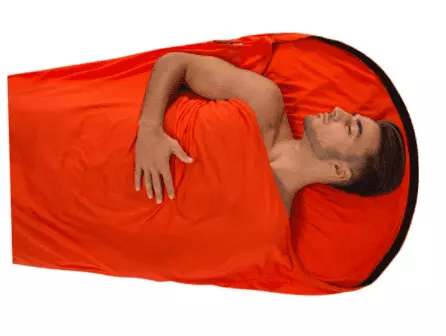
Adding a sleeping bag liner to your bag will immediately increase the temperature rating of your bag. It’s just one more layer of insulation between your body and the cold outside air. You may be surprised by how much a sleeping bag liner will increase the temperature rating in your bag.
There are a lot of different brands of sleeping bag liners available, but Sea To Summit is the undisputed Superbowl champ. They absolutely dominate the field providing the best sleeping bag liners on the market, but they can be expensive.
The vast majority of people should choose either the Sea To Summit Thermolite Liner (adds 25°F) or their Fleece Insulated Liner (adds 32°F). If you’re on a tight budget the Coleman Sleeping Bag Liner is cheap and provides 12°F to your bag.
They really add to the functionality of your sleeping bag. I use my Sea To Summit Thermolite Liner in the summer instead of a regular sleeping bag. It’s comfortable down to 50°F nights. In colder weather it gets used inside my 40°F sleeping bag to pad the temperature rating down to below freezing temps.
Sleeping bag liners also serve another important purpose. They keep dirt, sweat, body oils, and any other kind of grime off your sleeping bag and on the liner. So you won’t have to wash your sleeping bag as frequently, which causes premature wear on the bag. Every time you wash the bag the insulation compacts and gets less effective after each wash.
3) Buy A High R-Value Sleeping Pad
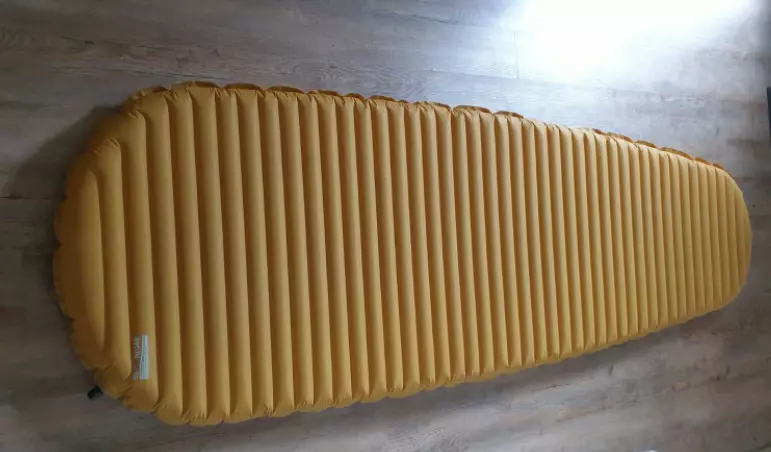
Your sleeping pad is almost as important for warmth as your bag. A sleeping pad isn’t solely about providing comfort! It also provides insulation protecting your body from the cold ground.
That’s why a regular air mattress isn’t a good alternative to a real sleeping pad. They provide comfort/padding, but there’s no insulation layer so you quickly lose body heat through the bottom of your sleeping bag. It might work as a temporary replacement in the summer, but you need a real sleeping pad on chilly nights!
Why don’t sleeping bags keep your back warm? Don’t they have filling around every part of the bag? Sleeping bags have insulation around the entire bag so they provide some warmth from the ground, but it won’t provide much.
As you lay on a sleeping bag the bottom insulation layer compresses down reducing the effectiveness of the fill. There will only be a thin layer of compressed insulation between your body and the cold ground. That’s where a sleeping pad comes in. It provides an additional insulation layer that can’t be packed down by your body weight. How much insulation your pad provides is measured by its R-Value.
Sleeping Pad R-Values Explained
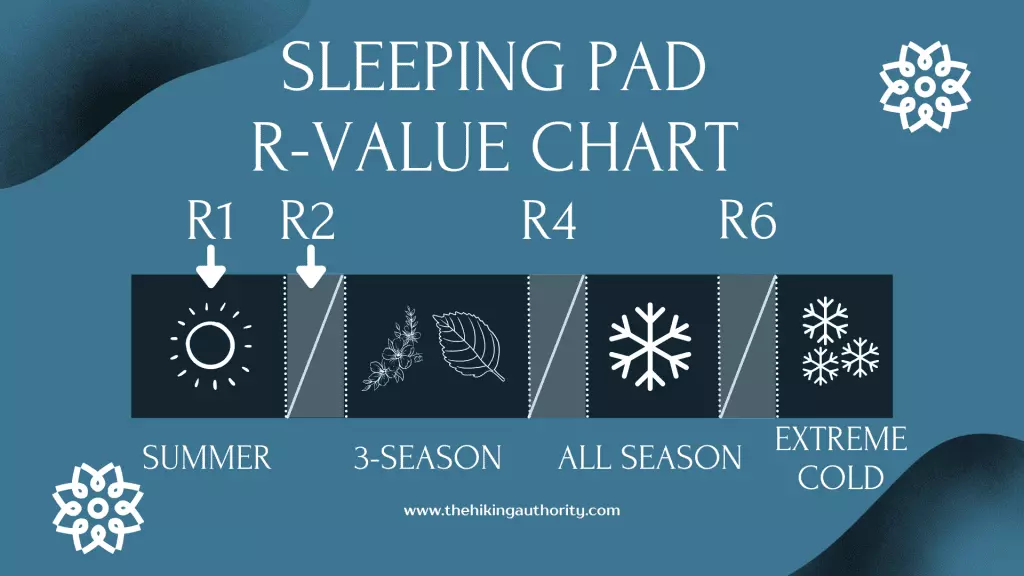
A sleeping pads R-Value tells you how much insulation it provides against the cold ground. Higher R-Value sleeping pads will provide more warmth on cold nights. Look at the handy R-Value chart above to get an overview on choosing a pad.
Low 1-2 R-Value pads should only be used in the warmer months late spring, summer, and early fall (down to 60°F). On colder spring/fall nights you will need a 3-4 R-Value pad (down to 40°F). Sleeping pads in the 4-6 range can be used in all seasons including winter(down to 0°F) and 6+ R-Value pads can be used in the winter when the temperature drops below 0°F.
Remember that you can always use a higher R-Value sleeping pad in warm weather. They help insulate you from the ground, but they won’t increase the temperature of your bag in the summer. You’ll be just as comfortable in the summer and the added padding will provide additional cushion against the ground.
Just make sure you get a wide enough sleeping pad for your body. A regular sized sleeping pad is only 20″ wide and most oversized pads go up to 25″. If you’re a bigger guy like me that means your arms will be hanging off the sides and you’ll be constantly rolling off your sleeping pad.
Reducing the amount of air in your sleeping pad will help, but there’s a better solution. I recommend going with an extra wide sleeping pad like the 30″ wide X-Large Thermarest Basecamp (6 R-Value) if you’re not worried about pack weight. It’s kind of heavy at 4lbs, but the added comfort more than makes up for the weight. Thanks to the higher 6 R-Value, you can use the same pad all year long!
Stacking Sleeping Pads For Additional Warmth
Choosing your sleeping pad wisely will allow you to use it all year long. I recommend going with a 3-4 R-Value inflatable or self-inflating pad for 3-Season use and using a secondary foam pad to increase warmth in the summer.
Stacking pads allows you to add the R-Value of both pads together for a higher overall insulation rating. Ultralight/lightweight backpacking sleeping pads tend to fall in the 3-4 R-Value range. That’s warm enough for 3-Season use, but it can get chilly in the winter.
Stacking a 3-4 R-Value pad on a 2 R-Value foam pad will give you a combined rating in the 5-6 range. That’s warm enough to be used in the winter and the added cushion will help protect your inflatable or self-inflating pad from punctures.
I like to use a dual pad setup even in warmer months when I’m not worried about trail weight. It provides extra cushion, and protects my expensive self-inflating pad from punctures. There’s really no downside other than added weight in my pack.
4) Wear Multiple Layers To Bed For Added Warmth
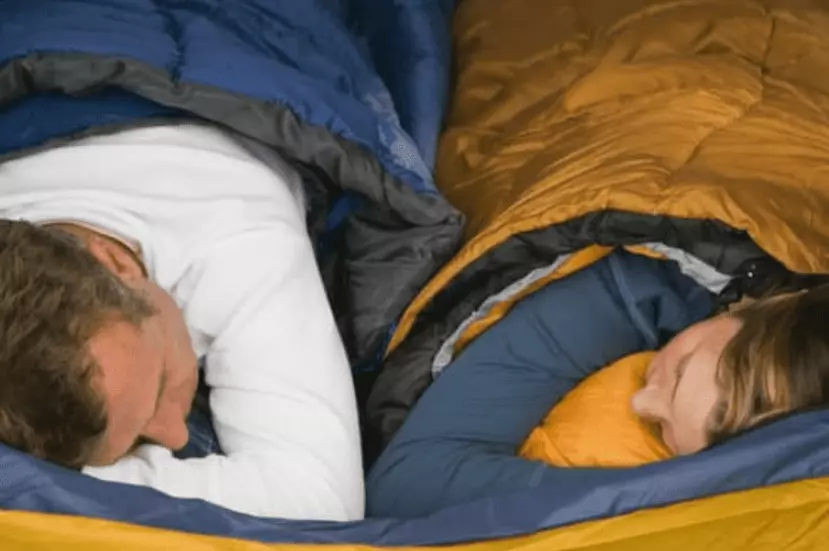
Don’t fall for the myth that it’s warmer to sleep naked in your sleeping bag! It’s almost always warmer to wear multiple layers to bed. Every layer you wear adds insulation between your body and the cold outside air.
Use the same three stage approach to layering that you use in cold weather. Wear a base layer to wick away sweat, middle layer for insulation, and exterior shell layer (optional). The shell layer is mostly to protect you against wind/water so you shouldn’t have to wear an exterior layer to bed. Feel free to wear a shell layer if you’re cold, but a tent and sleeping bag provide enough protection from the outside weather.
What To Wear In Your Sleeping Bag
- Base Layer Shirt: I normally go shirtless in the summer, T-Shirt in the spring/fall, and wear a merino wool thermal shirt on colder nights. Merino Tech Merino Wool Baselayers are affordable thermal shirts and they’re extremely comfortable. Smartwool shirts are a little bit warmer, but almost twice the price!
- Comfortable Pants or Shorts: Wear lightweight gym shorts in warm weather and long johns, pajama pants, or sweatpants in cold weather. I like to wear my merino wool long johns under a pair of sweat pants on chilly nights. You may even want to wear lightweight snow pants over your base layer in the winter.
- Merino Wool Socks: Sleeping bags provide consistent insulation throughout the bag, but most of your body heat is released through your torso. That means the center of your bag will be warm and it will get colder as you go farther down the bag. Wearing a pair of merino wool socks to bed will keep your feet warm evening out the temperature extremes in your bag.
- Light Jacket or Sweater (Cold Weather): You may want to put on a light jacket or sweater to keep your chest warm in cold weather. This isn’t necessary with a sleeping bag that’s rated for extreme temps, but it will really help if nighttime temps are nearing your bags rating. I carry a lightweight fleece jacket to wear at night, but a down puffer jacket (like this one) will keep you warmer at a similar trail weight. Feel free to layer up multiple jackets, but try not to contract the outside baffles on your sleeping bag.
- Winter Hat (Cold Weather): Your head won’t be protected in a sleeping bag so it’s important to wear a winter stocking cap on cold winter nights. Sleeping bag hoods provide some warmth while blocking the wind, but you should really consider wearing winter hat to bed in the cold.
- Mittens Optional (Cold Weather): There’s less blood circulating through your hands and feet so they’ll get colder than the rest of your body. I have a hard time sleeping in mittens, but a lot of cold weather campers wear them to bed. They’ll definitely help keep your hands warm so it’s worth considering.
5) Buy A Cold Weather Tent
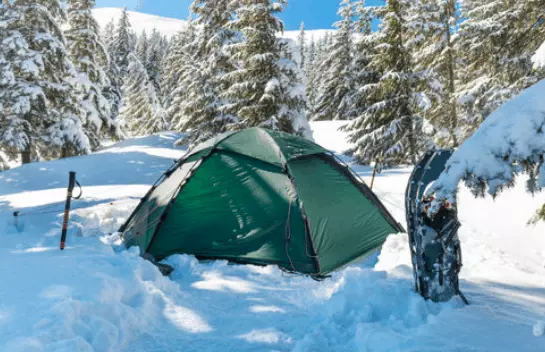
Your tent should be viewed as the last layer of protection between your body and the cold from outside. They help block the wind, but tents aren’t designed to keep in warmth. It will be slightly warmer inside a tent, but your sleep system does most of the work.
Most people use 3-Season tents that don’t offer much warmth (5°F Max). A 3-Season tent is designed to allow air to flow into the tent. This might sound stupid, but that’s only way to cut back condensation in the summer. Extra ventilation is great in the summer, but you’ll end up with a cool breeze flowing through the tent in the winter.
You can camp with a 3-Season tent in the summer, but they’re not ideal. That’s wear 4-Season tents (aka All-Season or winter tents) come in. These tents have two primary advantages for winter use. They’re sealed up to prevent drafts and they have sturdier designs to handle the weight of snow.
Reducing ventilation in your tent will add 10°-15° to the temperature inside your tent. That doesn’t sound like a lot, but it can make a huge difference on cold nights. It’s like adding a small boost to your sleeping bags temperature rating.
Mountaineering tents can make a huge difference to internal temperature adding 25°F to the inside of your tent. Throw on a heater for a few minutes and it will feel nice and toasty warm. Mountaineering tents are ridiculously expensive so I don’t recommend them unless you’re planning a trip above the tree line where you need the added snow and wind protection.
6) Use Alternative Heat Sources To Warm Up Your Sleeping Bag
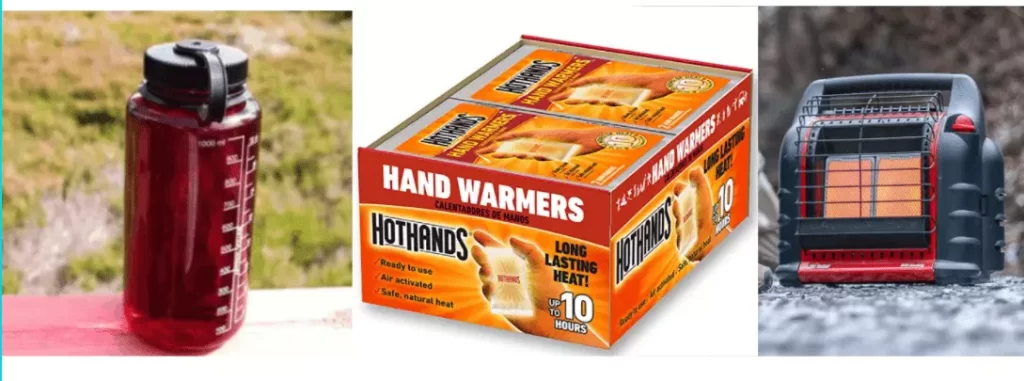
On extremely cold nights you might want to consider using alternative heat sources to heat up your sleeping bag. There are two primary ways to heat up your sleeping bag using external heat sources. You can heat up the surrounding air using a propane camping heater to slow down heat transfer or find a way to heat up the inside of your sleeping bag. I like to use a combination of both methods on particularly cold nights.
Let’s start off by talking about propane camping heaters. I’ve been carrying around a Mr Heater for as long as I can remember. It’s far too heavy to take backpacking so it only comes out when I’m camping close to my car. Just hook it up to a portable propane tank, set it on metal baking sheet to protect your floor, and it will heat up the inside of your tent.
Portable camping heaters have tip protection and don’t release carbon monoxide, but I don’t like to run the heater throughout the night. It’s nice for taking the chill out of your tent while you’re hanging out, but the propane tank only lasts 4-6 hours. I’ll turn it on for a few hours when it’s extremely cold at night, but your sleep system should provide most of your warmth.
That’s where internal heat sources come into play. You can either use a few disposable hand warmers in your sleeping bag or fill up a Nalgene Water Bottle with boiling water and place it between your legs. I prefer the water bottle method, because you need to keep a little bit of water ready to go so you can melt snow. Melting snow without seed water will quickly burn the bottom of your pot.
Other Tips to Keep Your Sleeping Bag Warm
Most of the above tactics revolve around maintaining warmth, but there are a few ways to increase body warmth. The following tricks should help you increase your natural body heat.
- Eat Before Bed: Eating a simple snack before bed will keep your body active throughout the night. Try to find complex carbs like energy bars and whole grains that your body can slowly digest.
- Find a Friend: Cuddling up with your partner shouldn’t be limited to sexy times. Find a couple size sleeping bag or consider zipping two bags together to conserve body heat.
- Exercise Before Bed: A little bit of exercise before bed will boost your metabolism throughout the night. Exercise enough to get warmed up without breaking out in a sweat.
- Try Not to Sweat: Sweat is designed to siphon heat away from your body. So after a long hike you’re going to want to put on clean dry clothes.
- Avoid Excessive Layers: Layering in your sleeping bag is always a great idea, but avoid overdressing. Check out my post on layering clothes in a sleeping bag.
- Pee Before Bed: A bloated bladder will make you noticeably colder. Make sure you pee before heading to bed and get up throughout the night whenever nature calls.
- Wear a Winter Hat: We’ve all heard the rumor that 50 percent of heat is lost through your head. While that’s definitely a myth you still want to slip on a beanie before bed.
